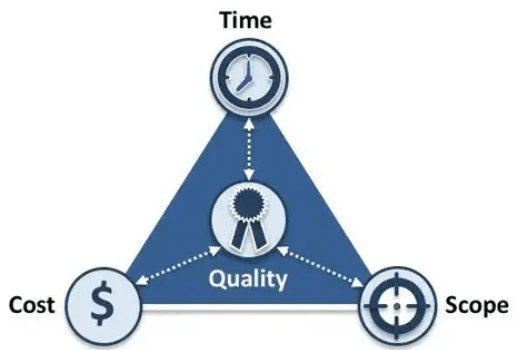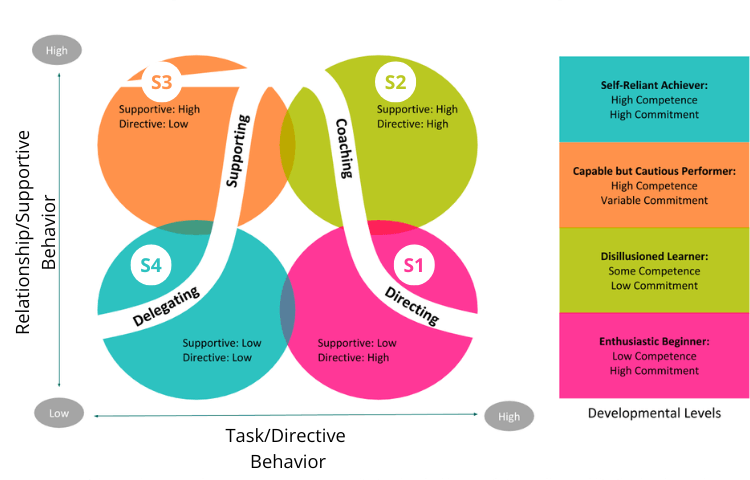Project Leadership: 7 Must to Have Skills for Successful Projects
Businesses run projects to create products and services, and in turn, they expect to make profits. Therefore, project management is crucial for businesses and successful project delivery is possible only through effective project leadership. We have listed the top seven skills that must be present in leadership in project management.
In this article
📌 Hint: Do not skip this article, you will find FREE Leadership Training resources throughout the article.
💡 You might be interested in the 12 Great Leaders Affected Our Lives in the Last 25 Years article.
What is Project Leadership?
Project management is delivering a unique product or service in a determined time with the required quality levels. Project leadership is the leaders, managers, and approach that will lead the project from the initiation to the end. Even though project leadership is generally associated with project managers or team leaders, it is an overall concept, vision, and approach to leading projects.
Project management is the art of balancing time, cost, scope, and quality. Because each of these parameters affects the other. For instance, if you are willing to increase the scope, it will add additional costs and time to the project. If you are willing to deliver a project faster, you have to sacrifice quality or scope, or you have to put in additional resources which will increase costs. If you are trying to reduce the costs of the project, you have to be prepared for delays or you have to reduce the scope. Since all these are connected to each other, this is referred to as a project management triangle.

As you cannot maximize each parameter, leadership in project management makes sure to find the optimum balance among these parameters. For instance, during requirements gathering, you can eliminate less important features to reduce scope., or you can look for the optimum materials to manage your costs.
Bad leadership has severe consequences for the organizations. Therefore, project leadership must possess certain skills to initiate, manage, and terminate successful projects.
7 Skills for Successful Project Leadership
Project leadership must possess several team leadership skills and generic leadership skills. However, some skills are more important for leadership in project management than others. We have listed the top 7 skills for successful project delivery.
1- Scope Management
Scope defines what needs to be done throughout the project. It is like an agenda or content of the project. For instance, if your project is a software development project, it details the specifications of the software, details, and processes in detail. Typically, the scope is defined by the customer. Project leadership works together with customers to list the project requirements and create the project scope.
By nature, customers are demanding. They will try to add as many features as possible to the product or project. Leadership in project management plays a vital role here in filtering the ever-coming requests, prioritizing them, and allowing only required and necessary features to the project. You must inform your client that there is no limit to adding new features to the project as long as you can wait for several months or even years and if you have a significant amount of budget.
Once the scope is finalized, make sure you get the buy-in of important stakeholders in the organization. You will not want to make a powerful stakeholder in the organization unhappy. You should communicate with the stakeholders during the scope creation process and inform them throughout the scope evolution.
Enhance Your Leadership Skills – Executive Leadership Training Program
San Francisco Business School offers an online, self-paced comprehensive executive leadership training program. You can consider enrolling in this program to improve your leadership skills.
2- Schedule Management
The second important skill for leadership in project management is schedule management. After the scope is finalized, each requirement and component of the scope are broken down into manageable and assignable tasks. Task-oriented leadership skills are important when breaking big tasks into smaller parts.
A big project can have hundreds even thousands of tasks. Some of these tasks can be performed in parallel while some tasks have to wait for another. For instance, if this is an e-commerce web page development project, one software developer can work on product page development and another one can work on user profile page development. If you have sufficient resources in the team, this parallel tasking will save time.
However, some tasks will have to wait for other tasks to be completed. For instance, testing of the product page can be done only after the development of the page is complete. This is called a finish-to-start dependency. Therefore, the test engineer should wait until the product page is ready.
Project leadership makes sure that an effective and efficient schedule for the project is developed. With the limited number of resources, you have to build a schedule that will complete the project in the shortest time.
Nothing goes as planned, especially in project management. Leadership in project management should be master of schedule optimization techniques such as crashing and fast-tracking. These skills will save time, especially when the project is behind schedule. These techniques are putting additional resources into the tasks to complete the tasks faster or doing tasks simultaneously instead of waiting for one task to finish to start another one.
Enhance Your Business Skills – SFBS Free Programs
One of the best ways to be a successful project leader is to improve yourself continuously. The best way to do this is, to enhance your competence through training programs. Take a step ahead and jumpstart your business competence. Enroll in our 1-hour Free Business Training programs.
3- Cost Management
Everything has a cost aspect when running projects. For instance, a senior employee has a higher cost to the organization compared to a less experienced employee. A quality material will cost more than a less-quality one. Project leadership comes into place here.
If you are using better resources or materials than is required, most probably, project cost than it should be. For instance, remember our e-commerce development project example. Let’s say product page development requires two to five years of experienced software engineer. If you perform this task with a senior software engineer, you will spend more than required for the project.
Similarly, leadership in project management must be cautious in material selection as well. Consider a house rehab project. If you have a limited budget and if you are renovating an apartment, there will be a significant cost difference between selecting regular tiles from the market or importing Italian marble.
The key to cost management is choosing the optimum resources. Not the cheaper ones or not the expensive ones.
4- Quality Management
Projects have quality metrics and targets as well. For instance, can you wait for an e-commerce webpage to load in 10 seconds? Well, if it had been 30 years ago, it would have been tolerable, but now, it is not. There is harsh competition in every aspect of business and there are industry-wide accepted averages for almost everything.
There is no limit to improvement as well. Therefore, project leadership must be careful to do the required things, in the required time and with a required budget. For instance, if the requirement of the product page load is under 2 seconds, if this is met, they should focus on the next task or challenge.
In some cases, some resources, especially the talented resources, may try to overperform. Even if they complete a task and it meets the requirements, instead of moving to the next task, they might be tuning for better results. This is called gold-plating in project management and the leadership in project management should monitor these kinds of cases to avoid delays in projects.
Watch Laura’s 30 Seconds Experience – Executive Leadership Training Program
Hear from Our Alumni Laura Smith, Head of Design. Laura attended the Executive Leadership Program at SFBS.

5- Communication
Communication, relationship, and interpersonal skills are crucial for all leaders. Based on research, project leadership spends 90% of their time on communication.
Professionals seek for confident and easy communication with their project leaders. They expect to see emotional intelligence and leaders who can see the issues from different perspectives. Have you seen leaders go to their room in the morning, go to meeting after meeting until the evening, and not set aside any time for their team? That’s an example of bad communication.
Project leaders should wander around and be visible to the people in their team. So, people should feel comfortable when communicating with their leaders and the leaders should be easily accessible. That is why professionals pick communication as the top leadership skill.
Project leadership is not only in communication with their subordinates. They have several communication channels within the organization and outside the organization. For instance, if the organization has a matrix organizational structure, the project leader will have to communicate with the line managers to request resources. If the same resource is required for another project, the leadership in project management has to negotiate with the other project leaders for the timely joining of the required resource.
Project leaders have to show reports to their executive leaders in the organization and to their clients. They have to inform the client regarding the project status and communication plays a vital role especially when things are not going well such as if there are delays.
6- Leadership in Project Management Must Be Situational
Situational leadership proposes that leaders apply one of the four different types of leadership in every situation or task they face. As there are different types of resources and people in the communication sphere of project leadership, they must possess situational leadership traits.
A Situational Leader employs one of four leadership styles that provide him or her with the highest probability of success in every situation they encounter. Those situations are a function of the task that needs to be performed, in conjunction with the task-related ability and willingness of the follower identified to perform it.
A project leader assesses the situation and how he can affect the follower or the performer of the task and applies one of the four styles. Hersey and Blanchard categorized these styles operationally as Task/Directive Behavior and Relationship/Supportive Behavior. You can see the four types of leadership behaviors in the following figure.

Let’s illustrate this over an example project.
A Good Example of Project Leadership – Marketing Project
To better illustrate project leadership, we will explain it through a fictitious scenario.
Richard is working as a Marketing Project Manager in a prestigious marketing agency, MarketPro. Recently, his manager assigned him a new product launch marketing project. Richard will work with one of the company’s most valued clients, Pharma King, for two months to generate a powerful marketing project for a new vitamin supplement they are launching.
Richard has four team members, David, Lisa, Chris, and Jane. Each has different levels of experience, motivation, and maturity. Here is how Richard manages each member during this short-term marketing project.
David – Junior Marketing Analyst
David joined the team one month ago. He just graduated from university and he does not have enough experience to perform the tasks on his own. David has gone through some training programs and this project will be his first professional assignment. He is willing to take tasks but he is worried if he can perform on his own.
So, Richard applies the S1: Directing style of situational leadership for David.
Lisa – Creatives Professional
Lisa has two years of experience and MarketPro is her first job. She has worked on different marketing projects before however, this will be her first experience in a marketing campaign for a pharmaceutical company, so she has some hesitations although she is willing to take on new tasks.
So, Richard applies the S2: Coaching style of situational leadership for Lisa.
Chris – Senior Marketing Expert
Chris is a senior marketing expert with over 8 years of experience. MarketPro is his third job and he has been working here for more than three years. Chris worked on various projects, including launching pharma products as well. Chris was expecting a promotion in the last organization change, and he could not get it, so he is a little bit demotivated.
So, Richard applies S3: Supporting style of situational leadership for Chris.
Jane – Marketing Team Lead
Jane has over 10 years of experience in marketing. She has worked in reputable companies and joined Market Pro two years ago. Jane launched similar products for similar companies more than 10 times. Richard and Jane worked on various projects together and he knows that Jane has an “assigned me and consider it done” style. Jane earned a grade in the company this year and is considered a role model even from other functional departments.
So, Richard applies S4: Delegating style of situational leadership for Jane.
You can consider the Blake Mouton Management Model as well for leading project resources.
7- Team Building
Projects are performed with teams. Strong teams can produce great results and project leadership must work on team-building activities to improve bonds among project teams. Team building is growing strong teams that have strong professional bonds and perform efficiently to provide better outputs. Tuckman identifies team building in five stages:
- Forming: The team is gathering at this stage. The team is structured, and no one knows each other enough.
- Storming: The team starts to perform and interpersonal conflicts start to arise.
- Norming: In this stage, team members are creating new ways of doing and being together. Team members start to trust each other.
- Performing: The most productive stage of the team. Everyone knows each other, and support is at the highest degree.
- Adjourning: The work is finished, and the team adjourns.
The critical moments in teams are when a new one joins the team, or if the whole team is formed recently. Leadership’s team-building skills will play a significant role in minimizing conflicts and reaching the maximum performance level.
3 Fundamental Project Leadership Styles
We have listed 7 skills you must apply for successful project delivery. What about the project leadership styles you should apply for successful projects? For different types of organizations and environments, different styles of leadership are required. We have listed this under this heading.
1- Creativity and Innovation Requiring Projects – New Age Organizations
Creativity and innovation require freedom. It is less likely to expect creative ideas, new perspectives, or innovative thinking to occur under autocratic leadership where there is minimum participation. Delegative or laissez-faire leadership is a very hands-off management approach. When you use this style, you allow team members to set their own goals and deadlines, and you let them determine how to do their work.
The laissez-faire leadership style fosters creativity as it requires maximum group collaboration and participation. The group finds its own ways, methods, and path to reach its goals. When doing this, team members participate in group meetings and discussions, and this leads to new ideas, creative solutions, and out-of-the-box thinking as a result.
Therefore, if creativity is required in the project, project leadership can apply a laissez-faire leadership style. Some of the works that require creativity can be:
- New product development
- Artwork creation
- Research and development projects
- Marketing projects
You can enhance this list.
2- Time-Critical Projects – Traditional Organizations
Emergencies, time-critical tasks, and having an inexperienced team are the best cases for the project leadership team to apply autocratic leadership. Autocratic leadership, also known as authoritarian leadership, is a leadership style where leaders or managers have full control and authority to make all decisions with limited input or participation from the team members or others. Autocratic leaders make decisions on their own using their intuition, experience, moral values, and insights. They take no input or limited input from the others.
- Emergency cases: quick decisions and fast reactions are needed in case of emergencies. This requires minimum time to decide on a solution. Autocratic leadership will work in emergencies.
- Time-critical tasks: When there is time pressure, there might not be time to evaluate different perspectives and opinions from the team. Autocratic leaders make decisions, and team members follow orders. Therefore, autocratic leadership may be beneficial for time-sensitive projects or tasks.
- Inexperienced teams: If your team members are junior and need maximum guidance to perform, autocratic leadership may be better. Also, it is less likely to receive creative ideas from junior professionals, so, group participation may not be needed if you have an inexperienced team.
3- Process-Based and Bureaucratic Projects – State and Government Organizations
Safety-requiring projects, such as aviation, state, and government projects are heavily dependent on policies, rules, and standards. In these types of environments, project leadership can apply bureaucratic leadership traits. A bureaucratic leadership style is appropriate for serious safety risks such as working with machinery, with toxic substances, at dangerous heights, or with large sums of money. Bureaucratic leadership is also useful for managing employees who perform routine tasks.
The bureaucratic leadership may sound repressive and old school. However, it is still popular and used as the best project leadership style in many cases. Some of the organizations that may favor the bureaucratic leadership style are government agencies, the army, and security companies. Strict discipline, authority, and a clear chain of command are required in these types of organizations.
You may consider applying bureaucratic leadership in cases such as:
- Large and complex organizations when a hierarchical organization is needed for efficient management.
- When the work requires a high level of authority and predictability.
- If the work requires adherence to rules and standards such as compliance with laws or regulations.
For instance, consider a Boeing employee working in the aviation system implementation. The work requires specialization, there must be clear rules and standards defining how the worker should enter the working area, what to do, and how to exit. Otherwise, there might be severe consequences of not following the rules.
Summary
Project leadership makes sure the project scope is delivered on time, on budget, and at the required quality levels. There are seven important skills that project leadership should possess for successful project delivery. These are scope management, schedule management, cost management, quality management, communication, situational leadership, and team building.
Depending on the culture of the organization and project type, leadership in project management should apply different leadership styles. Creativity and innovation requiring projects require a laissez-faire leadership style, time-critical projects require an autocratic leadership style, and state, government, and projects that require high safety measures require a bureaucratic leadership style.

